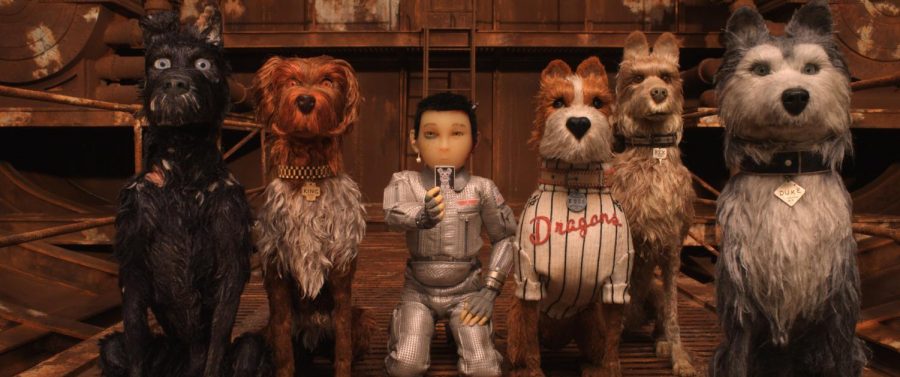“Isle of Dogs” impresses with unique style
(From L-R): Bryan Cranston as “Chief,” Bob Balaban as “King,” Koyu Rankin as “Atari Kobayashi,” Bill Murray as “Boss,” Edward Norton as “Rex” and Jeff Goldblum as “Duke” in the film ISLE OF DOGS.
April 10, 2018
Wes Anderson’s most recent film, “Isle of Dogs,” offers a quirky and stylistically offbeat tale about man’s best friend and how mankind chooses to respond when said friend is put in danger.
Fans of Anderson’s work will be pleased to see that he maintained his iconic style. However, the general air of the film is less whimsical and more serious than what’s usual for him, likely as a result of the more weighty subject matter. The animation also seemed more mature than that of his previous venture into stop-motion, “Fantastic Mr. Fox.”
The film opens with a fictional legend of a young boy who defeated the corrupt head of the Kobayashi dynasty in order to save all of dogkind. The plot then switches over to the future in a Japanese city named Megasaki, where the mayor has banished all dogs to an island of trash. However, when the young boy Atari (Koyu Rankin) flies to the island to find his dog, the worlds of both species are irreversibly changed.
The majority of dogs in the main pack demonstrate the mindset of dogs being man’s best friend, with Rex (Edward Norton), Duke (Jeff Goldblum), Boss (Bill Murray), and King (Bob Balaban) being melancholy without their owners and missing their lives as housepets. The fifth dog Chief — voiced by “Breaking Bad” star Bryan Cranston — is alienated from them as a result of having lived as a stray before being sent to the island, causing some conflict within the group.
Surprisingly, I don’t have much else to say about the film’s many canines — at least, not without spoilers — because as the film implies, dogs are inherently good. They are considered excellent companion animals for a reason, and it’s evident why by the time the credits roll.
The human aspect of “Isle of Dogs” is thoroughly interesting. For starters, throughout the film, the citizens of Megasaki never speak English. I enjoyed this, interpreting it as a unique take on expressing the language barrier between us and our pets.
Even though they weren’t the main focus, I enjoyed the portrayal of the Megasaki scientific community. The scientists are shown to be deeply passionate about their work and persistent despite everything working against them. Professor Watanabe (Akira Ito) in particular stands up for his cause bravely, facing all consequences head on.
After contemplating what I saw from one particular character in the film, the American exchange student attending the Megasaki High School, Tracy Walker (Greta Gerwig), is a symbol of American cultural appropriation. Just regarding her physical appearance alone, the character wears a stereotypical Japanese schoolgirl outfit and her blonde hair in a massive afro despite being white. In her interactions with the Megasaki citizens she is blunt, oftentimes to the point of blatant disrespect, and when she eventually experiences repercussions for her actions she seems absolutely shocked.
I’ll admit that as someone who is not Japanese I do not know precisely where the line is between what’s okay and what is too much. I think that Wes Anderson generally did a decent job with incorporating the culture appropriately, but he did make several errors. The most noticeable of these are the instances of stereotyping, which manifest in Japanese gang members, a young hacker, and a painful overuse of haikus.
As a final warning, if blood and violence makes you especially uncomfortable, this may not be the best choice. Even though it is stop-animation, Wes Anderson did not shy away from shots of ears being ripped off, bloody head injuries, and even a detailed surgery scene. It definitely warrants the PG-13 rating, and I would not recommend bringing younger children to see it.
Overall, I genuinely enjoyed the film despite its flaws, and inspired by the message, subsequently hurried home after seeing it to cuddle with my own canine friends.
















